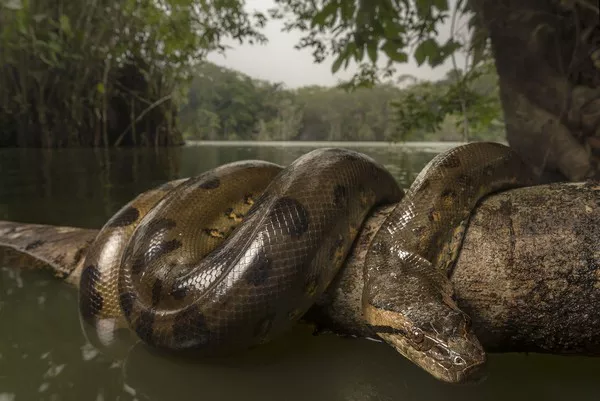Snakes have captivated human fascination for millennia, from their elegant movements to their diverse adaptations. Among the myriad species that slither across our planet, some stand out for their sheer size and weight. In this exploration, we delve into the realm of the world’s heaviest snakes, marveling at their impressive dimensions and understanding the ecological significance of these magnificent reptiles.
The Top 10 Heaviest Snakes
1. The Green Anaconda (Eunectes murinus)
Undoubtedly one of the most iconic giants of the snake world, the Green Anaconda reigns supreme in terms of sheer mass. Native to the lush swamps and marshlands of South America, particularly the Amazon Basin, these behemoths can reach astonishing lengths of over 29 feet and weigh in excess of 550 pounds. With their muscular bodies and aquatic prowess, Green Anacondas are apex predators, preying on a diverse array of creatures, including fish, birds, and even large mammals. Their robust build and formidable hunting skills make them vital components of their ecosystems, regulating prey populations and maintaining ecological balance.
2. The Reticulated Python (Python reticulatus)
Hailing from the dense jungles of Southeast Asia, the Reticulated Python stakes its claim as one of the world’s largest snake species. Known for its striking pattern of intricate geometric markings, this python can attain staggering lengths of up to 23 feet and weigh an impressive 330 pounds or more. Renowned for their ambush hunting strategy, Reticulated Pythons possess immense strength, capable of overpowering prey as formidable as deer and wild boar. Despite their imposing size, these serpents are reclusive by nature, often preferring to avoid human encounters unless provoked.
3. The Burmese Python (Python bivittatus)
Named for its native range in the marshes and forests of Myanmar (formerly Burma), the Burmese Python ranks among the largest snake species on Earth. With lengths exceeding 18 feet and weights surpassing 200 pounds, these formidable constrictors command respect wherever they roam. Burmese Pythons have garnered attention in recent years due to their establishment in the Florida Everglades, where they pose a significant threat to native wildlife. Their voracious appetite and ability to adapt to diverse environments make them formidable invasive predators, underscoring the importance of addressing the ecological impacts of exotic species introductions.
4. The African Rock Python (Python sebae)
Residing across the savannas and rocky outcrops of sub-Saharan Africa, the African Rock Python ranks among the continent’s largest and most formidable reptiles. With lengths approaching 20 feet and weights exceeding 200 pounds, these serpents command respect from both prey and predators alike. African Rock Pythons are opportunistic hunters, preying on a variety of mammals, birds, and reptiles, including antelope and crocodiles. Despite their impressive size, these pythons face numerous threats, including habitat loss, human persecution, and poaching for their skins, highlighting the urgent need for conservation efforts to protect these majestic creatures.
5. The Indian Python (Python molurus)
Endemic to the forests and grasslands of the Indian subcontinent, the Indian Python ranks among Asia’s largest snake species. With lengths reaching up to 20 feet and weights exceeding 200 pounds, these formidable constrictors play a vital role in maintaining ecological balance in their native habitats. Indian Pythons are highly adaptable predators, capable of hunting a wide range of prey, including rodents, birds, and even small deer. Despite their ecological importance, these serpents face numerous threats, including habitat loss, poaching, and human-wildlife conflict, underscoring the need for comprehensive conservation measures to safeguard their future.
6. The Amethystine Python (Morelia amethistina)
Native to the rainforests and coastal regions of northern Australia and New Guinea, the Amethystine Python stands out for its striking iridescent scales and impressive size. With lengths exceeding 20 feet and weights surpassing 160 pounds, these arboreal giants are among the largest snakes in Australia. Amethystine Pythons are skilled climbers, often taking refuge in the dense canopy of the rainforest, where they prey on a variety of mammals, birds, and reptiles. Despite their formidable reputation, these serpents face numerous threats, including habitat destruction, road mortality, and persecution by humans.
7. The Boa Constrictor (Boa constrictor)
Spanning a vast range across Central and South America, the Boa Constrictor ranks among the continent’s largest and most widespread snake species. With lengths reaching up to 13 feet and weights exceeding 100 pounds, these muscular constrictors are formidable predators in their native habitats. Boa Constrictors are ambush hunters, relying on stealth and strength to overpower prey ranging from rodents and birds to monkeys and small deer. Despite their ecological importance, these serpents face numerous threats, including habitat loss, poaching for the pet trade, and human persecution, highlighting the need for conservation efforts to ensure their survival.
8. The Scrub Python (Morelia kinghorni)
Endemic to the rainforests and scrublands of northern Australia and New Guinea, the Scrub Python is renowned for its impressive size and arboreal lifestyle. With lengths exceeding 20 feet and weights surpassing 100 pounds, these formidable constrictors are among the largest snakes in Australia. Scrub Pythons are skilled climbers, often inhabiting the dense canopy of the rainforest, where they prey on a variety of mammals, birds, and reptiles. Despite their ecological importance, these serpents face numerous threats, including habitat destruction, road mortality, and persecution by humans.
9. The Anaconda
The term anaconda refers to several large, aquatic snakes found in tropical South America. The green anaconda (Eunectes murinus) is the largest and heaviest of all anaconda species, with females capable of reaching lengths of over 29 feet and weights exceeding 550 pounds. These colossal serpents inhabit the swamps, marshes, and slow-moving streams of the Amazon Basin, where they are apex predators, preying on a variety of aquatic and terrestrial creatures. Despite their formidable size and strength, anacondas face numerous threats, including habitat destruction, hunting for their skins, and conflicts with humans, underscoring the need for conservation efforts to protect these iconic reptiles.
10. The Titanoboa (Titanoboa cerrejonensis)
Although extinct for millions of years, the Titanoboa deserves mention for its awe-inspiring size and status as the largest snake ever to have lived. Discovered in the Cerrejón coal mine in Colombia, this prehistoric behemoth roamed the swamps and marshes of South America approximately 60 million years ago. Estimates based on fossil evidence suggest that Titanoboa could reach lengths in excess of 42 feet and weigh over 2,500 pounds, dwarfing even the largest modern snakes. Despite its ancient origins, Titanoboa offers valuable insights into the evolutionary history of snakes and the ecological dynamics of prehistoric ecosystems.
See also: The Heaviest Elephant In The World
Conclusion
In conclusion, the world of giant snakes is a realm of wonder and fascination, where these magnificent creatures play vital roles in shaping ecosystems and captivating human imagination. From the mighty Green Anaconda to the awe-inspiring Titanoboa, these colossal serpents remind us of the remarkable diversity and resilience of life on Earth. As stewards of our planet, it is incumbent upon us to safeguard these majestic reptiles and ensure their survival for generations to come.
You Might Be Interested In:
- Animals in the World – You May Not Know” href=”https://www.validdownloads.com/archives/2327″ rel=”bookmark”>13 Most Unique Animals In The World – You May Not Know
- The Biggest Rhino In The World – White Rhino!
- The World’s 4 Cutest Panda – You May Not Know

























